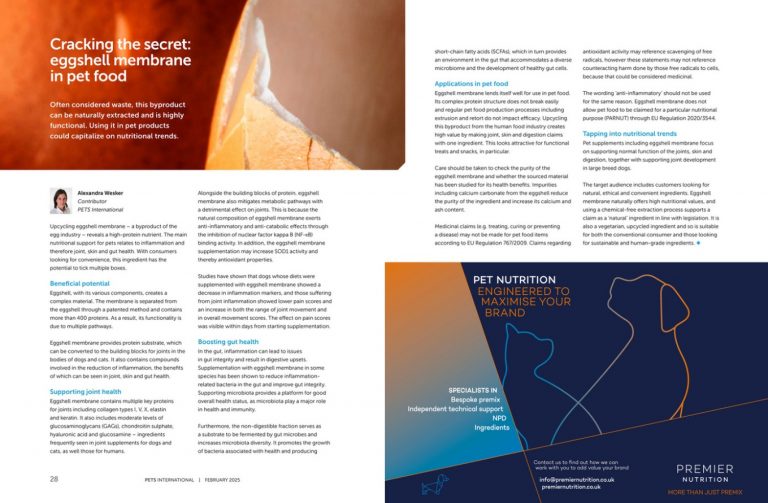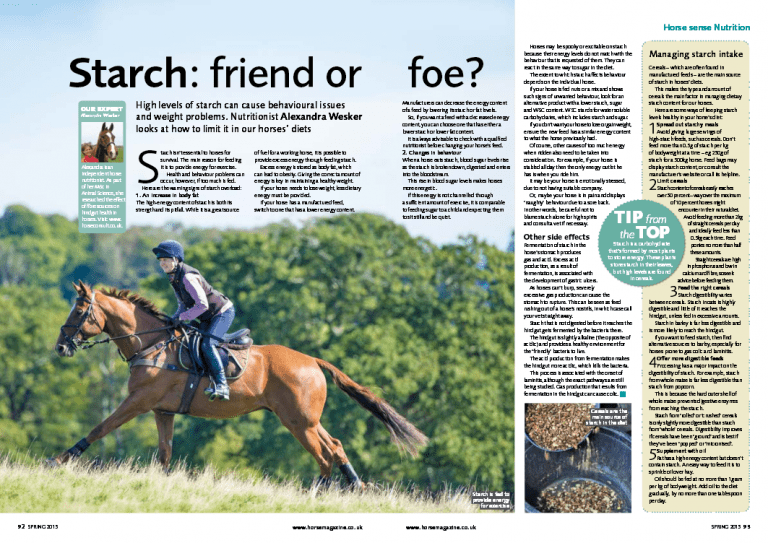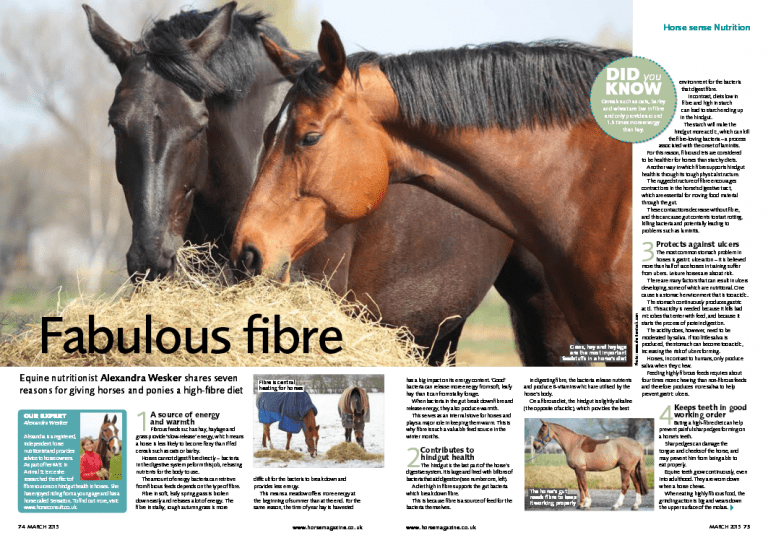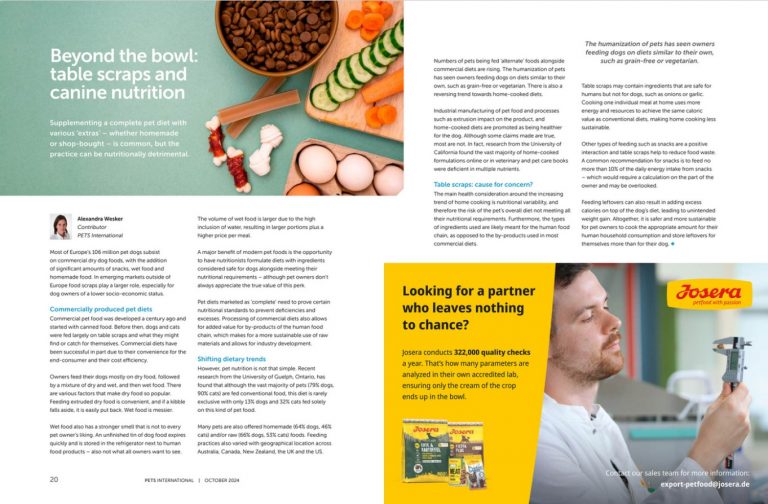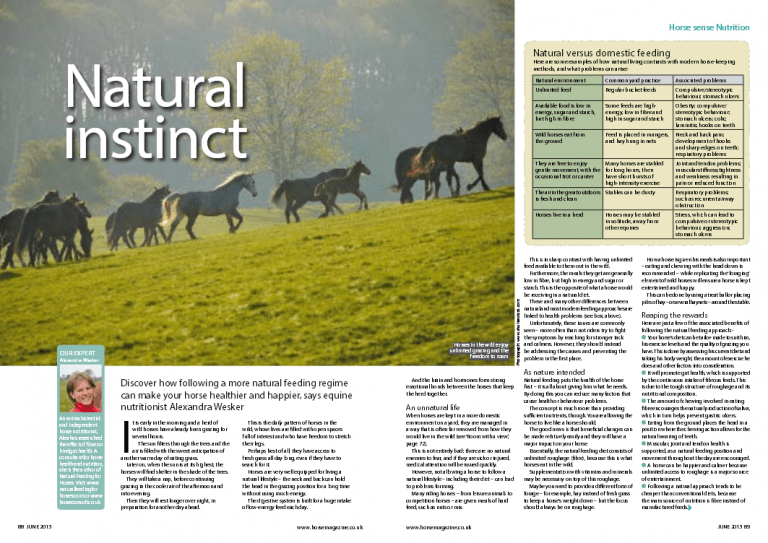Q&A Horse Nutrition
As published in Horse Magazine
Alex writes and consults on equine well-being and nutrition. She has a BSc and MSc in Animal Science and wrote the book Natural Feeding for Horses.
Why won’t she eat up?
My Thoroughbred is easily distracted from her feed, and won’t eat up if there’s something going on at the yard – which there often is. I’m worried as she is losing weight. How can I increase her interest in food?
Alexandra says You can make it more palatable by feeding bananas, carrots or chunks of apple (cut to prevent choking). She might be more interested in feed of a different structure, such as mash or muesli mix.
Adding herbs can help: horses generally love them, especially mint. Sugar or molasses are tasty, but can cause dental problems or may make her picky about her feed in the future.
You can add extra calories by adding oil, increasing the amount gradually, by one tablespoon a day. Further actions need to be taken if more than 100ml per day is fed, or choose a high energy, low sugar/starch feed.
Decrease distraction by feeding at less busy times or in a different location. Play music to make sudden noises blend in. If possible, feed her while others are fed, to encourage her to show the same behaviour.
Get a dentist to check there is no dental reason for reduced feed intake.
Can he live on fibre?
My Irish Sports Horse currently has a bucket feed twice a day, but I’d like to phase this out and give him more of a fibre-based diet. Would this be suitable, and what advice can you give me to make the transition a success?
Alexandra says You should replace hard feed with about 1-1.5 times as much roughage, if it provides less than 10MJ of energy per kilogram, or with 2-2.5 times as much roughage if it provides more than 10MJ per kilogram. Check the feed bag for this information, or contact an equine nutritionist if you need help working it out.
Make dietary transitions gradually and keep a close eye on your horse and his condition. If his bodyweight remains stable, then energy and protein content is sufficient.
Adding interest to his diet
I want to add interest to my good doer’s diet as he is only fed hay in the winter. What do you suggest?
Alexandra says The best thing you can do is give your horse unlimited roughage. If you aren’t feeding him ad lib hay, then you should give him more. You may need to find hay of a lower nutritional content to prevent weight gain.
If your horse is kept with others who are given hard feed in a bucket, then he may get jealous, stressed and show aggressive or stereotypic behaviour. To prevent this, you can consider feeding him low-energy grass pellets instead of concentrates. If you want to take it a step further, you can make him a custom-made mix of vegetables, fruits, bran and alfalfa to create a mash with water.
Feeding the bran and alfalfa together should improve the mineral balance of the mash. But avoid feeding more than a handful of each, as alfalfa can easily provide too much energy for your good-doer.
Getting his five a day
Is it safe to feed my horse vegetable scraps from my kitchen? I know carrots, swedes and parsnips are safe, but what about cabbage, cauliflower, sprouts and potatoes?
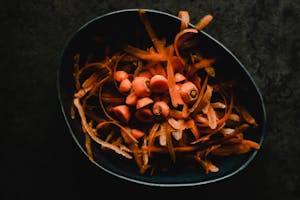
Alexandra says Cabbage, cauliflower and sprouts are part of the Brassicaceae family of vegetables, as are kale, radish, turnip and broccoli. The high vitamin C and soluble fibre content make these vegetables sound like a healthy option. However, the gas production associated with them means that feeding more than 50-100 grams should be avoided, as it can lead to gas colic. Feeding small amounts of cabbage is associated with supporting the digestive system against ulcers, but I would recommend other things first.
Potatoes and tomatoes should be avoided. The green skin of potatoes and tomatoes is toxic and can affect a horse’s nervous system and cause colic. Starch in uncooked potatoes is not broken down in the first part of the digestive system and can lead to gas colic in the hindgut. Especially toxic are the green potato plants which appear above ground.
Which hay should I use?
My hay supplier has three or four types of hay, taken from different fields or made at different times of year. How do I tell which is best?
Alexandra says Have a close look at the hay before making a purchase. The most important thing is that it contains no poisonous plants or mould. If poisonous plants are present – such as ragwort – do not consider feeding it.
The time of harvest is the next most important factor. The most nutritious hay is harvested before flowering, usually around May. Less nutritious is hay harvested after the grass has flowered, around June. Hay that is harvested later in the year is likely to provide too little energy, protein, vitamins and minerals for most horses.
How do I avoid winter laminitis?
I’m worried about the possibility of my daughter’s pony – who lives out – getting laminitis from frosty grass. Is any horse prone to getting laminitis this way, and how can I avoid it?
Alexandra says Laminitis is a complex problem with many factors contributing to it, and research into the disease is ongoing. Horses are more likely to develop laminitis if they are obese, rather than at a healthy weight. And ponies are more prone to the condition, than warmblood horses. Your pony is more likely to suffer with the condition during winter months if he has had it before – known as recurrent laminitis – than he is to develop it for the first time.
Frosty grass is indeed associated with the development of laminitis due to its high fructan (sugar) content. Fructan is formed under sunlight and is used for grass growth. Grass growth slows down with low temperatures, causing fructan accumulation.
Letting horses live out all year long allows their digestive system to adapt to any changes in fructan. The adaptation means horses are less likely to develop laminitis than if they were to suddenly change from a hay diet to frosty pasture. However, the risk is still high and the more prone your horse is to getting laminitis, the more frosty grass and other factors should be avoided.


